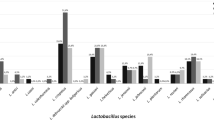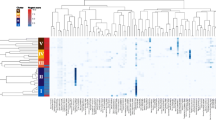Abstract
Lactobacilli play an important role in maintaining the vaginal health of women. The development of suitable bacterial replacement therapies for the treatment of vaginosis requires knowledge of the vaginal lactobacilli species representation. The aim of this study was to identify at the species level vaginal Lactobacillus isolates obtained from Bulgarian women in childbearing age by using different molecular methods. Twenty-two strains of lactobacilli isolated from vaginal samples were identified and grouped according to their genetic relatedness. A combined approach, which included amplified ribosomal DNA restriction analysis (ARDRA), ribotyping and polymerase chain reaction (PCR) with species-specific oligonucleotide primers was applied. All vaginal isolates were grouped into 5 clusters in␣comparison with a set of 21 reference strains based␣on the initial ARDRA results, which was then confirmed by ribotyping. Finally, the strains were subjected to PCR analysis with eight different species-specific primer pairs, which allowed most of␣them to be classified as belonging to one of␣the␣following species: Lactobacillus crispatus, Lactobacillus fermentum, Lactobacillus gasseri, Lactobacillus helveticus and Lactobacillus plantarum. In conclusion, this study suggests that the most straightforward identification strategy for vaginal lactobacilli would be grouping by ARDRA or ribotyping, followed by PCR specific primers identification at species level.
Similar content being viewed by others
Abbreviations
- ARDRA:
-
amplified ribosomal
- DNA:
-
restriction analysis
- BV:
-
bacterial vaginosis
References
Andreu A (2004) Lactobacillus as a probiotic for preventing urogenital infections. Rev Med Microbiol 15:1–6
Antonio MA, Hawes SE, Hillier SL (1999) The identification of vaginal Lactobacillus species and the demographic and microbiologic characteristics of women colonized by these species. J Infect Dis 180:1950–1956
Bjorkroth J, Korkeala H (1996) rRNA gene restriction patterns as a characterization tool for Lactobacillus sake strains producing ropy slime. Int J Food Microbiol 30:293–302
Brosius J, Ullrich A, Raker MA, Gray A, Dull TJ, Gutell RR, Noller HF (1981) Construction and fine mapping of recombinant plasmids containing the rrnB ribosomal RNA operon of E. coli Plasmid 6:112–118
Bruce AW, Reid G (1988) Intravaginal instillation of lactobacilli for prevention of recurrent urinary tract infections. Can J Microbiol 34:339–43
Chagnaud P, Machinis K, Coutte LA, Marecat A, Mercenier A (2001) Rapid PCR-based procedure to identify lactic acid bacteria: application to six common Lactobacillus species. J Microbiol Methods 44:139–48
Chang CE, Pavlova SI, Tao L, Kim E-K, Kim SC, Yun HS, So J-S (2002) Molecular identification of vaginal Lactobacillus spp. isolated from Korean women. J Microbiol Biotechnol 12:312–317
Charteris WP, Kelly PM, Morelli L, Collins JK (1997) Selective detection, enumeration and identification of potentially probiotic Lactobacillus and Bifidobacterium species in mixed bacterial populations. Int J Food Microbiol 35:1–27
Collins MD, Rodrigues UM, Ash C, Aguirre M, Farrow JAE, Martinez-Murcia A, Philips BA, Williams AM, Wallbanks S (1991) Phylogenetic analysis of the genus Lactobacillus and related lactic acid bacteria as determined by reverse transcriptase sequencing of 16S rRNA. FEMS Microbiol Lett 77:5–12
De Man JD, Rogosa M, Sharpe ME (1960) A medium for the cultivation of lactobacilli. J Appl Bacteriol 23:130–135
Delley M, Mollet B, Hottinger H (1990) DNA probe for Lactobacillus delbrueckii. Appl Environ Microbiol 56:1967–1970
Dicks LM, Silvester M, Lawson PA, Collins MD (2000) Lactobacillus fornicalis sp. nov., isolated from the posterior fornix of the human vagina. Int J Syst Evol Microbiol 50:1253–1258
Eschenbach DA, Davick PR, Williams BL, Klebanoff SJ, Young-Smith K, Critchlow CM, Holmes KK (1989) Prevalence of hydrogen peroxide-producing Lactobacillus species in normal women and women with bacterial vaginosis. J Clin Microbiol 27:251–256
Giorgi A, Torriani S, Dellaglio F, Bo G, Stola E, Bernuzzi L␣(1987) Identification of vaginal lactobacilli from asymptomatic women. Microbiologica 10:377–384
Hillier SL, Krohn MA, Klebanoff SJ, Eschenbach DA (1992) The relationship of hydrogen peroxide-producing lactobacilli to bacterial vaginosis and genital microflora in pregnant women. Obstet Gynecol 79:369–373
Holzapfel WH, Haberer P, Geisen R, Bjorkroth J, Schillinger U (2001) Taxonomy and important features of probiotic microorganisms in food and nutrition. Am J Clin Nutr 73:365S–373S
Kilic AO, Pavlova SI, Alpay S, Kilic SS, Tao L (2001) Comparative study of vaginal Lactobacillus phages isolated from women in the United States and Turkey: prevalence, morphology, host range, and DNA homology. Clin Diagn Lab Immunol 8:31–39
Massi M, Vitali B, Federici F, Matteuzzi D, Brigidi P (2004) Identification method based on PCR combined with automated ribotyping for tracking probiotic Lactobacillus strains colonizing the human gut and vagina. J Appl Microbiol 96:777–786
McLean NW, Rosenstein IJ (2000) Characterisation and selection of a Lactobacillus species to re-colonise the vagina of women with recurrent bacterial vaginosis. J␣Med Microbiol 49:543–552
Miteva V, Boudakov I, Ivanova-Stoyancheva G, Marinova B, Mitev V, Mengaud J (2001) Differentiation of Lactobacillus delbrueckii subspecies by ribotyping and amplified ribosomal DNA restriction analysis (ARDRA). J Appl Microbiol 90:909–918
Miteva V, Stefanova T, Budakov I, Ivanova I, Mitev V, Gancheva A, Ljubenov M (1998) Characterization of bacteriocins produced by strains from traditional Bulgarian dairy products. Syst Appl Microbiol 21:151–161
Pavlova SI, Kilic AO, Mou SM, Tao L (1997) Phage infection in vaginal lactobacilli: An in vitro study. Infect Dis Obstet Gynecol 5:36–44
Schleifer KH, Stackebrandt E (1983) Molecular systematics of prokaryotes. Annu Rev Microbiol 37:143–187
Sieber R, Dietz UT (1998) Lactobacillus acidophilus and yogurt in the prevention and therapy of bacterial vaginosis. Int Dairy J 8:599–607
Silvester ME, Dicks LM (2003) Identification of lactic acid bacteria isolated from human vaginal secretions. Antonie Van Leeuwenhoek 83:117–123
Sobel JD (2000) Bacterial vaginosis. Annu Rev Med 51:349–356
Song YL, Kato N, Matsumiya Y, Liu CX, Kato H, Watanabe K (1999) Identification of Lactobacillus species of human origin by a commercial kit, API50CHL. RBJSKS 10:77–82
Tilsala-Timisjarvi A, Alatossava T (1997) Development of oligonucleotide primers from the 16S-23S rRNA intergenic sequences for identifying different dairy and probiotic lactic acid bacteria by PCR. Int J Food Microbiol 35:49–56
Ventura M, Casas IA, Morelli L, Callegari ML (2000) Rapid amplified ribosomal DNA restriction analysis (ARDRA) identification of Lactobacillus spp. isolated from fecal and vaginal samples. Syst Appl Microbiol 23:504–509
Walter J, Tannock GW, Tilsala-Timisjarvi A, Rodtong S, Loach DM, Munro K, Alatossava T (2000) Detection and identification of gastrointestinal Lactobacillus species by using denaturing gradient gel electrophoresis and species-specific PCR primers. Appl Environ Microbiol 66:297–303
Wilks M, Wiggins R, Whiley A, Hennessy E, Warwick S, Porter H, Corfield A, Millar M (2004) Identification and H2O2 production of vaginal lactobacilli from pregnant women at high risk of preterm birth and relation with outcome. J Clin Microbiol 42:713–717
Zhong W, Millsap K, Bialkowska-Hobrzanska H, Reid G (1998) Differentiation of Lactobacillus species by molecular typing. Appl Environ Microbiol 64:2418–2423
Acknowledgements
We would like to thank Dr Vanya Miteva for the support and valuable advice that she provided during this study. This study was financed by the National Council for Scientific Research, Republic of Bulgaria - grant for young scientists MU-L 1406/2004.
Author information
Authors and Affiliations
Corresponding author
Rights and permissions
About this article
Cite this article
Stoyancheva, G.D., Danova, S.T. & Boudakov, I.Y. Molecular identification of vaginal lactobacilli isolated from Bulgarian women. Antonie van Leeuwenhoek 90, 201–210 (2006). https://doi.org/10.1007/s10482-006-9072-z
Received:
Accepted:
Published:
Issue Date:
DOI: https://doi.org/10.1007/s10482-006-9072-z




